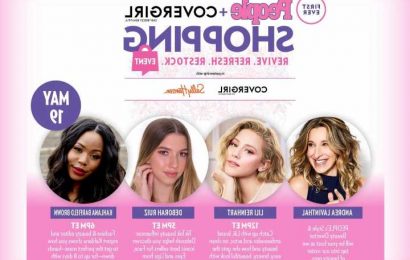As every impatient person among us knows, hair extensions are the way to fast-track the otherwise long journey to mermaid-length hair. But the reality is, they’re not just for adding length or volume.
Hair extensions are truly a gift from angels for hiding a bad haircut. Or experimenting with a different hair color or style — bangs, anyone? — before taking the plunge. They’re also excellent for pandemic boredom relief: I doubt I’ll ever color my hair turquoise, but a few electric blue clip-in streaks (without the damage from dyes) on a Wednesday afternoon, why not?!
Thankfully, hair extensions have shedded their reputation of being obvious, due in large part to a surge in demand across age groups, upgrades in the hair extension quality, and not to mention, they’re just fun.
“Hair extensions have become so popular because women are looking for easier ways to maintain their natural hair, and extensions are also a protective style,” says Kahh Spence, Cardi B. and Kehlani’s go-to stylist (who also makes his own custom wigs). “You’re able to color, cut, and do anything you want with extensions without the worries of affecting your natural hair, which is such a beautiful feeling.”
On the flip side, the recent explosion of hair extension products means that making a selection is even more overwhelming, so we tapped celeb stylists and extensions wizards, Spence along with Sally Hershberger Hudson Yards’ magician, Jan-Marie Lozada, to break down all the different types of extensions, how long they’ll last (and how much they’ll set you back), and the at-home care you'll need to jot down to keep your bundles glossy and smooth.
What Are the Different Types of Hair Extensions?
“When looking to purchase hair extensions, it’s best to lead with what you’re planning on using them for,” explains celeb stylist, Jan-Marie Lozada. She also notes that the best extension for a short-term, one-night transformation for, say, a bachelorette party, is different than an extension you’re planning to wear long term.
Clip-ins
These extensions are easy to use and the most affordable. Clip-ins look like ordinary barrettes, only with hair attached, and are fastened by simply clipping the piece into hair just beneath the root. “They’re great for a quick, easy and noncommittal transformation,” says Lozada, who adds that with a little styling, clip-ins are easily integrated with natural hair. Spence adds, “[They're] made for women who are on the go and don’t have the time or can’t do permanent extensions.”
Tape-ins
Tape-ins look similar to clip-in pieces, but the hair is attached to sections of strong, double-sided tape and are secured by placing and pressing the tape between rows of natural hair to achieve what Spence calls a “flat and seamless look.”
“[They] add length and volume around the whole head to give the illusion of thicker hair, without putting excess strain on natural hair,” explains Lozada.
Sew-ins
Sew-ins are more commonly referred to as a weave, which are hand-sewn with a needle and thread into your natural hair that has been braided horizontally from ear to ear.
Glue-ins
Also known as keratin bonds, are the most versatile type of hair extension best suited for long term wear and often applied in a salon. “These are great for individuals who are active and constantly changing up their hairstyles from up in a bun to wearing hair down, and ultimately blends the most seamlessly with real hair,” says Lozada.
Halo extensions
These work as one complete hair unit, with hair flowing down from a clear, circle-shaped wire that fits around the hairline, similar to a halo, topped with a layer of your own hair to hide any trace of an attachment. Lozada considers a halo to be the easiest to use, hide, and style into natural hair, from a high pony to cascading waves, and everything in between.
VIDEO: The 8 Breakout Haircut Trends of 2021, According to Top Stylists
Do Hair Extensions Work for All Hair Types?
“Every hair type requires a different kind of extension,” cautions Spence. “Depending on your natural hair texture, you want to go for non-synthetic hair that will blend well with it. For example, the women with type 4 hair need to search for a hair extension with a texture of a tighter curl/coil to match their hair exactly or close to it.”
For hair types 3 and 4, Spence reaches for the brand Conscious Curls Hair because their wide variety of extensions made specifically for curls and coils makes texture-matching a breeze.
“If your hair is more on the straighter or wavier side, look for an extension that will blend perfectly,” says Spence, who suggests the versatile brand True Indian Hair for types 1 and 2, and for a seemingly endless range of styles and colors, Lozada likes Glam Seamless extensions.
Regardless of hair texture, be sure to follow Spence’s golden rule for hair extensions: “You want to make sure the hair is 100% human and/or virgin for ALL textures, as synthetic hair or a synthetic-blend will not last long.”
But if you’re looking to really level-up, no extension is more luscious than the virgin REMY hair category, which Lozada calls the “best natural hair extension option on the market.” REMY is defined as totally pure, untouched human strands of hair that have never been dyed or processed, with its cuticles still intact (versus chemically stripped away).
Can Hair Extensions Damage Your Natural Hair?
“Any time pressure is being applied to hair, you are putting it at risk of damage,” cautions Lozada. “All types of hair extensions can contribute to damage and breakage if mishandled, which is why it’s important to utilize quality products, and when possible, have them applied by a professional.”
Spence also reminds us that a little bit of caution goes a long way, especially during extension application and removal. He warns that clip-ins can snag onto hair causing breakage, while tape-ins can tug and — worst case scenario — pull out sections of hair, so even though it’s fake hair, treat it with TLC.
To reverse any hair damage or weakness, be sure to use nourishing and healing hair masks, like Lozada’s favorite, K18 Biomimetic Hairscience Leave-In Molecular Repair Hair Mask, each time you take a break from wearing extensions.
To shop: $75; k18hair.com
How Long Do Hair Extensions Last?
Shelf life will vary based on the type and quality of the extension, in addition to how well they are maintained, but as a general rule of thumb, Lozada estimates that “Keratin bonds can last up to three months, while clip-in, tape-in, and halo extensions can last anywhere from three to six months, but this largely depends on how frequently they are used.”
How Should I Care for My Hair Extensions at Home?
To ensure extensions stay intact, treat them as if they were your own hair and brush frequently, recommends Spence. “And if they’re oily at some point, cleanse them, condition them, and show them the same amount of love you would show your natural hair. My favorite conditioner is OGX Argan Oil of Morocco Hydrating Hair Conditioner.”
To shop: $11; target.com
Source: Read Full Article










